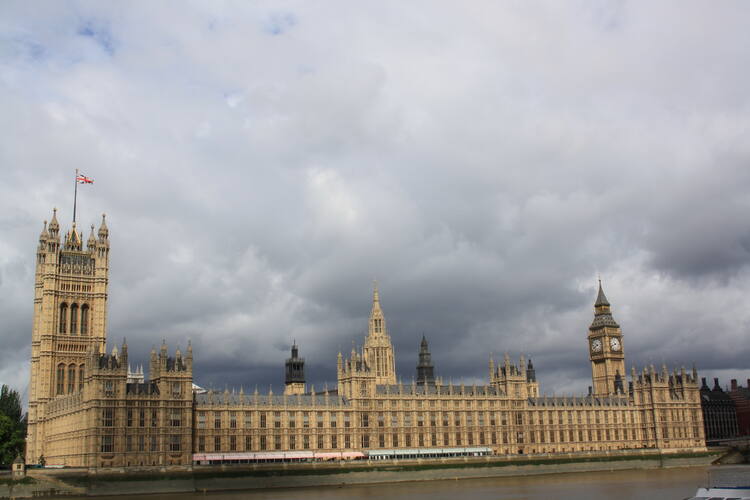The departure was not at Tilbury as we expected, instead we took off from and under the Tower Bridge!!! The crew decorated the ship with banners, balloons, fruit carvings, and all sorts of other goodies. Each of us were given an English flag to wave and a glass of champagne. The captain blew the whistle and we were underway with Rule Britannia playing on the loudspeakers and folk on the shore waving at us as we passed by. Very emotional and a very beautiful sail away. There is no way to capture the excitement but here's what we saw....
The pilots came through the Tower Bridge to lead us out to the channel. We also got to see some police action as one of their boats came roaring past with lights and sirens going. I swear I didn't do anything - promise!
The smokestacks gave us the first clue we were about to be underway.
With all due respect to Ty Pennington..."move that gangplank!!!!" and they did.
The little boat you see is a wooden speed boat.
Soon we were leaving the HMS Belfast behind. We were moored next to her and in fact had to get on board our ship by walking across her.
The HMS Belfast was named for the Northern Irish capital of Belfast. Construction was begun in 1936 and she was launched on St. Patrick's Day 1938. Commissioned in August 1939 right before WW-II began, the Belfast was part of a naval blockade against Germany. In November of the same year she ran into a German mine and spent two years being repaired. She came back stronger than ever and saw action the rest of the war including the Normandy invasion and was part of the Korean War as well. In 1967 she was saved from the scrap yard and turned into a museum that opened in 1971.
A beautiful British lady was standing next to me as we sailed away. Her father had been aboard the Belfast during the war and they had brought him to London to celebrate a recent birthday. The museum staff gave him a birthday to remember according to her.
And we are off...……
Let the party begin!
Some of what we saw in the next hour.
The Thames Tunnel was built between 1825 and 1843 and was the first tunnel to have been constructed beneath a navigable river. It measures 35 feet wide by 20 feet high and is 1,300 feet long, running at a depth of 75 feet below the river surface measured at high tide. The tunnel was originally designed for horse-drawn carriages, but was never used for that purpose.
Above in the center is a building affectionately called the "Kim Kardashian" building. You may draw your own conclusion why they call it that.
To the right is the "Cell Phone" building. Self evident.
There are thirteen vistas protected by The London View Management Framework including both Westminster Palace and St. Paul's Cathedral from different vantage points around the city. This could be one reason for oddly shaped buildings - there is also a cheese grater.
The Shard gets its name from the top of the building that looks like a shard of glass. It is an office building, hotel and has retail establishments, ten residential apartments, restaurants and bars in it as well. It is 1016 feet tall, 95 stories tall, has 1,307,383 million square feet, and opened in 2014.
I have no idea, but the light hitting it as we sailed by made it stand out.
The Cutty Sark, last of the tea clippers that were no longer needed when the steam propulsion ships and Suez Canal made trade from China faster. Built in 1869.
The Royal Hospital for Seamen at Greenwich, began life as a palace and was not a hospital as we know it, instead it was a hospitable place for those that needed it. Queen Mary II was moved by the seamen returning from the Battle of La Hogue in 1692 and ordered the King Charles wing of the palace to be converted to a hospital for seamen as a counterpart to the Chelsea Hospital for soldiers. The original plans would block the view of the River Thames from the Queen's House so the plans were redesigned to split the buildings and have an avenue coming through the hospital grounds to the house and Greenwich Hill behind the house.
The Millennium Dome was constructed to celebrate the third millennium. It was opened from
January 1, 200 to December 31, 2000 and was home to the Millennium Experience. It was not the success it was thought it would be and cause quite a political stink because of that. There is symbolism in the design of the building. The twelve yellow poles represent the months of the year or the hours of a clock and it is circular measuring 365 meters - one for each day of the year. The roof weighs less than the air inside the dome. I did hear one reference to "Major's Folly" referring to Prime Minister John Major who was in power when the idea was conceived.
As we slept and throughout the next the captain safely got us to Guernsey.
Lots of whispers were heard in London but what will Guernsey say? Stay tuned.






















































































































